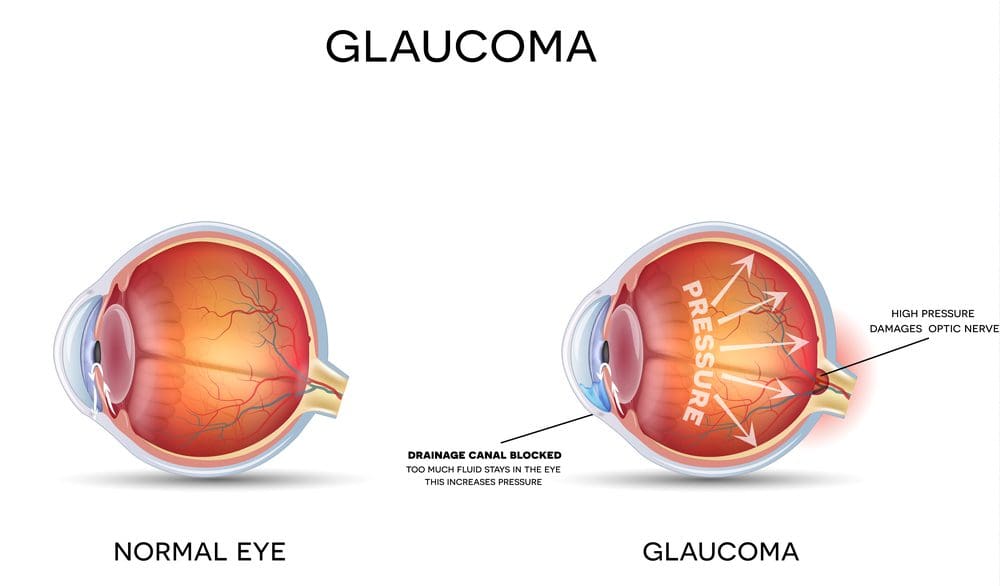MIGS for Glaucoma: The Best Surgical Option in 2022?
Home / Diagnosed With Glaucoma /
Last Updated:
Table of Contents
Glaucoma refers to a group of eye disorders that are a leading cause of vision loss and blindness among Americans. Glaucoma damages the optic nerve by preventing fluids from draining properly from the eye.
MIGS, or minimally invasive glaucoma surgery, is a relatively new approach to glaucoma treatment. Referring to a group of minimally invasive procedures, MIGS offers alternative surgical treatment options for glaucoma that pose fewer risks than traditional glaucoma surgeries.
If you have mild to moderate glaucoma and are looking for a surgical treatment approach that is minimally invasive to your life, a MIGS procedure may be a good option for you. There is some debate, however, about the efficacy of MIGS

While MIGS has only been around for about 10 years, other surgical options have been around for over 50 years for the treatment of glaucoma. Other surgical treatment options for glaucoma include trabeculectomy, drainage implants, and laser surgery.
In preparation for MIGS surgery, make sure you know what to expect. The surgery is relatively quick and you won’t feel it, though you will likely be awake. Your doctor will also give clear preparation and recovery instructions that are important to follow closely.
There are pros and cons associated with MIGS. While the risks of MIGS are much lower than with traditional glaucoma surgeries, the procedures can be less effective and tend to work best on mild to moderate cases of glaucoma.
Understanding Glaucoma
Glaucoma refers to a group of eye disorders that cause progressive damage to the optic nerve. With glaucoma, people lose nerve tissue that is essential for seeing.
Without proper treatment, glaucoma can lead to total vision loss. According to the American Academy of Ophthalmology, glaucoma is the leading cause of blindness for people over the age of 60.
You deserve clear vision. We can help.
With 135+ locations and over 2.5 million procedures performed, our board-certified eye surgeons deliver results you can trust. Your journey to better vision starts here.
Glaucoma occurs primarily in people over the age of 40, and it may be a hereditary disease. It is estimated that more than 2 million people in the United States are living with glaucoma.
When fluids build up in the front part of your eye, excess pressure is put on the eye, which can damage the optic nerve. The two main types of glaucoma are:
- Primary open-angle glaucoma. This is the most common type of glaucoma, and it occurs gradually. Damage to the optic nerve occurs as the result of fluid not draining properly from the eye. This type of glaucoma is usually painless, and you may not initially notice any changes to your vision. This makes it particularly dangerous since it can go undetected until damage to the eye has occurred. Regular eye exams are essential to catch it in its early stages.
- Angle-closure glaucoma. Also known as closed-angle glaucoma or narrow-angle glaucoma, this type of glaucoma can cause an acute attack in which the drainage angle in your eye gets completely blocked by your iris. When this happens, eye pressure suddenly rises and symptoms come on rapidly. Emergency eye care should be sought right away in the case of an acute angle-closure glaucoma attack, as it can lead to blindness.
Both types of glaucoma develop over time, and both are chronic conditions. Often, there are no symptoms at first, so it is difficult to recognize when damage is being done to your eye. Regular eye exams for people who are at risk for eye disease are the best way to promote overall eye health.

What Is MIGS?
Although glaucoma is a progressive disease with no real cure, early intervention can usually prevent further vision loss, including blindness. Minimally invasive glaucoma surgery (MIGS) is a treatment approach focused on lowering eye pressure in order to prevent or reduce harm to the optic nerve.
While all types of glaucoma surgery share the same goal of lowering eye pressure, MIGS has been specifically developed with the goal of reducing the risk of complications associated with traditional glaucoma surgeries.
MIGS refers to a group of procedures that use microscopic-sized equipment and minimal incisions in the eye. Types of MIGS operations include:
- Microtrabeculectomies. Microscopic-sized tubes are inserted into the eye to drain fluid. Devices that are excellent at lowering pressure in the eye and safer than traditional trabeculectomy devices are used.
- Trabecular surgery. Through a special contact lens on the eye, a tiny device is inserted via a small incision into the trabecular meshwork. The damaged meshwork can then be destroyed or bypassed. Mostly useful for early to moderate stages of glaucoma, this procedure hasn’t been shown to reduce eye pressure significantly.
- Suprachoroidal shunts. Small tubes are inserted to connect the front of the eye to the suprachoroidal space in order to support fluid draining from the eye. With a low rate of serious complications, this procedure is effective at lowering eye pressure in moderately severe cases of glaucoma.
- Milder versions of laser photocoagulation. Recent advances in the laser treatment of glaucoma include endocyclophotocoagulation and micropulse cyclophotocoagulation. These procedures help to reduce the eye’s ability to produce fluid and can assist with advanced stages of glaucoma.
When MIGS Is the Best Option
A relatively new concept, there is some debate about using MIGS as the first surgical intervention to glaucoma treatment.
patient receiving cataract surgeryOver the past 10 years, MIGS has gained traction as a surgical approach designed to lower intraocular pressure in a minimally invasive way. The main surgical treatment over the past 50 years, however, has been trabeculectomy.
Some researchers argue that MIGS is not a sufficient replacement for conventional surgeries, like trabeculectomies. They believe MIGS cannot be as effective at draining fluid from the eye for the long term. Trabeculectomies, however, have been proven affordable, effective, safe, and long-lasting procedures.
Opponents of traditional glaucoma surgeries argue that there are often complications associated with the procedures, and results are variable. The same technique used on the same person by the same doctor can produce different results in each eye.

Supporters of MIGS believe they are effective and sufficient substitutes for more invasive glaucoma surgeries. Through the lens of patient-centered care, most patients prefer the least invasive interventions available. MIGS offers few risks, a short hospital stay, minimal post-operative care, and a short recovery period, while effectively treating glaucoma.
You deserve clear vision. We can help.
With 135+ locations and over 2.5 million procedures performed, our board-certified eye surgeons deliver results you can trust. Your journey to better vision starts here.
Other Surgical Treatment Options for Glaucoma
The traditional mode of treatment for glaucoma is prescription eye drops. Eye drops and other medications can be taken regularly to prevent the buildup of fluid in your eye. This is how glaucoma is treated in its early stages.
For more difficult cases of glaucoma that aren’t responding well enough to eye drops or medication, there are surgical treatment options.
Surgical treatment options for glaucoma include:
- Laser surgery. Laser trabeculoplasty is done to drain fluid from the eye. A laser is used to stimulate the trabecular meshwork (the structure that drains fluid from the eye), so fluids can drain more efficiently. Drawbacks to this option are that the results can be temporary and the procedure may need to be repeated at some point in the future.
- Conventional surgery. Trabeculectomy is the conventional surgical approach for glaucoma treatment. A drainage flap is created in the eye, so fluids can drain more efficiently and not create pressure on the eye.
- Drainage implants. Through drainage valve implant surgery, a small silicone tube is placed into the eye to help fluids drain properly. Adults with uncontrolled or secondary glaucoma, as well as children with glaucoma, may benefit from this treatment option.
MIGS Surgery: What to Expect
All MIGS surgeries are designed to be minimally invasive. This includes the procedure itself, as well as the preparation for and recovery from the procedure.
Here is an idea of what to expect if you are getting MIGS surgery:
- Preparation: Prior to surgery, your doctor will instruct you on which medications you can or cannot take, and if you need to stop eating ahead of time (often the night before).
- The surgery: The steps of the surgery itself depends on which MIGS operation you and your eye doctor have decided is the most appropriate for you. In general, there will be limited surgical manipulation. You will most likely be awake for the surgery, although anesthetic eye drops will be given so you don’t feel anything, other than some potential light pressure on your eye. You can also expect a shorter surgery time than with traditional glaucoma surgeries.
- Recovery: Due to the minimally invasive nature of MIGS, recovery time is also minimal. Most people respond well to the surgery and experience improved vision right away, though you may have some eye soreness. Minor discomfort generally dissipates within a few days. It is important to follow all of your eye doctors’ instructions for post-surgery eye care. Proper care will help to prevent infection and other complications.

The Pros & Cons of MIGS
Experts at the Glaucoma Foundation acknowledge that while MIGS greatly increases the safety of glaucoma eye operations, some effectiveness is lost.
Many ophthalmologists have found that MIGS is not appropriate for patients with advanced glaucoma and very high eye pressure. In these cases, traditional glaucoma surgery will usually be recommended.
However, MIGS can be very effective for treating mild to moderate cases of glaucoma. Your eye doctor will assess the current status of your vision when determining if MIGS is a good option for you.
Like all surgical options, MIGS is highly effective at preventing future vision loss. What has already been lost cannot be regained, and glaucoma cannot be entirely prevented or cured, but your chances of further vision loss and blindness are greatly reduced with MIGS.
You deserve clear vision. We can help.
With 135+ locations and over 2.5 million procedures performed, our board-certified eye surgeons deliver results you can trust. Your journey to better vision starts here.
References
- Glaucoma. American Optometric Association.
- Glaucoma Surgery Series: Minimally-Invasive Glaucoma Surgeries (MIGS). (November 2018). BrightFocus Foundation.
- Minimally Invasive Glaucoma Surgery (MIGS) Is a Poor Substitute for Trabeculectomy: The Great Debate. (June 2018). Ophthalmology and Therapy: U.S. National Library of Medicine.
- What Is Glaucoma? (August 2019). American Academy of Ophthalmology.
- What Is MIGS? (September 2019). Glaucoma Research Foundation.
- Glaucoma. (July 2019). National Eye Institute.
- Minimally Invasive Glaucoma Surgeries (MIGS). Touch Ophthalmology.
- Choosing MIGS: For You and Your Patient. (June 2018). Review of Ophthalmology.
This content is for informational purposes only. It may have been reviewed by a licensed physician, but is not intended to serve as a substitute for professional medical advice. Always consult your healthcare provider with any health concerns. For more, read our Privacy Policy and Editorial Policy.